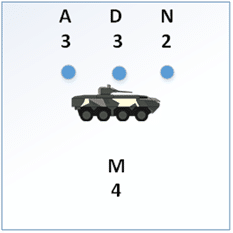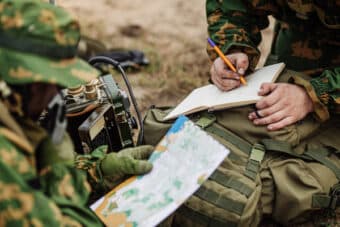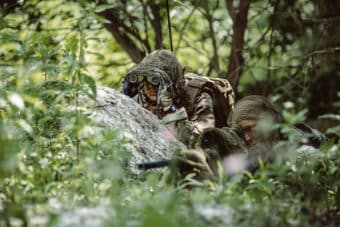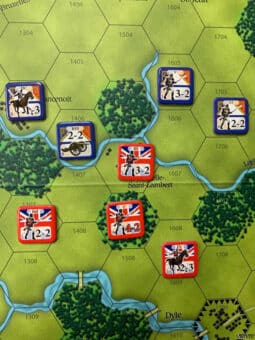Wargaming Hybrid Warfare Part III: Complexity, Networks, and Emergence
by Roger Mason PhD
 Introduction
Introduction
For the past few years, there has been a debate among wargame designers. Is the design process art or a science? There are very capable designers on both sides of the argument. Science provides organization and facilitates analysis. However, I believe a good wargame design involves painting a picture.
Some topics are familiar and easy to depict. Designing a new Civil War or WWII North Africa campaign game means the designer is painting a portrait of familiar ground. Hybrid warfare is not so familiar. How would you depict hybrid warfare? It seems chaotic, especially to the victims. Is the best depiction one of unpredictable actions and outcomes?
Hybrid warfare involves the manipulation of systems to influence outcomes. This article will discuss the systems affecting hybrid warfare and how they can be incorporated to improve a wargame design. The use of systems theory offers the possibility of emergence where the intersection of systems and player behavior results in new situations and conditions.
Definitions
There are four systems concepts that will help us understand hybrid warfare and how to wargame it: chaos, complexity, networks, and emergence.
Chaos
The commonplace definition of chaos is disorder and confusion. The uncertainty and disorder of hybrid warfare seem chaotic. The scientific use of the term chaos is more than merely an unpredictable form of disorder. In science, chaos or chaos theory is the study of unpredictable or random behavior in systems controlled by deterministic laws. Stephen Kellert defines chaos theory as “the qualitative study of unstable aperiodic behavior in deterministic nonlinear dynamical systems”
A system bound by deterministic laws and yet demonstrate unpredictable behavior can be chaotic. These systems are sensitive to initial conditions and unstable with irregular oscillations. Within a system nonlinear means there is no direct relationship between independent and dependent variables. Hybrid warfare has defined inputs and outputs subject to the conditions of the environment. Hybrid warfare appears chaotic but not in a scientific sense. So, how can we define it?
 Complexity
Complexity
Complexity is the study of systems involving uncertainty and non-linearity. Professor Murray Gell-Mann observed, “Complexity results from the interrelationship, inter-action, and elements within a system and between a system and its environment.”
Complexity theory, unlike chaos, involves interaction within the elements of a system. Dr Neil Johnson of George Washington University defines complexity as “The study of phenomena which emerge from a collection of interacting objects.” The result of these interactions is self-organization prompted by environmental changes.
A complex adaptive system involves a system where internal elements or agents interact. Individual interactions combined with environmental changes can result in unique outcomes. These are outcomes that would not occur individually. Some of the complex adaptive system indicators are a dynamic system where the elements are in motion, sensitivity to the environment, unpredictable behavior, and self-organization.
The description of a complex adaptive systems seems to fit with a hybrid ground offensive where conventional and proxy forces attack employing a variety of force options to spread disorder. To include these factors in a game we must understand the framework the system is built upon.
 Networks
Networks
Within a complex adaptive system are networks. Networks are comprised of interconnected nodes. Military and societal networks have a similar function. These networks support the system and provide local connections to global systems. These connections enhance the local capability to act or access resources. The development of networks has changed how systems function.
A good example is the evolution from 19th to 21st century in artillery employment. In the 19th century, you needed to be adjacent to an artillery unit to direct fire at a visible target. In the 21st century, you can request artillery via cyberspace to fire remotely at a hidden target located by sensors. The improvement of networking makes this possible.
Networks can facilitate multi-domain operations, enhance communications, and increase the ability to gather intelligence. The connections within networks can stimulate greater complexity and resilience of the network. They provide the basic foundation for self-organization within a system. The more effective the network the stronger the system they support.
Hybrid offensive operations target a defender’s networks in several ways. In hybrid operations, the value of destroying and replacing enemy networks may outweigh the destruction of enemy forces. Hybrid operations interact with a defender’s networks in three ways. First, the advancing forces are seeking to destroy enemy networks. This is followed by organizing replacement networks for the systems which have been overrun. Finally, the aggressor must balance resources between offensive capabilities and self- organization to maintain their networks.
 Emergence
Emergence
The New England Complex Systems Institute defines emergence as “The existence of collective behaviors, what parts of a system do together they would not do alone…. Emergence describes how collective behavior arises from parts.” Emergence can also describe the relationship between parts of a system and its environment. As new behaviors emerge, they may interact with one another resulting in additional outcomes.
There are several advantages to building emergence into a game design. First, emergence will expose unanticipated interactions. These are situations and conditions that otherwise might remain hidden below the surface of the game. Secondly, emergence increases game granularity through self-generation. Granularity comes not from more rules but the outcomes of behaviors.
Emergence can facilitate the development of secondary behaviors. As interactions and behaviors occur and arise, the outcomes can influence the game environment. These environmental changes can lead to new outcomes impacting future behaviors. This functions as a feedback loop. These factors can increase realism. The players are dealing with force threats within a dynamic battlespace.
One of the great benefits is limiting the need for “the invisible hand.” The invisible hand is the game mechanics and procedures designed to control the direction and tempo of the game. The more realism designers try to pull out of a game the more complicated the mechanics become. Emergence makes this much simpler.
The exposure of new interactions and behaviors, the self-generation of granularity, the emergence of secondary behaviors, greater realism, and simplicity provide a more comprehensive platform for analysis. The depth of the interactions and emergence of new behaviors can provide a greater understanding of the scenario. This understanding exceeds what is possible from a standard two-dimensional game.
 Modeling Tipping Points
Modeling Tipping Points
Hybrid warfare is about pushing your opponent over the threshold to the point where self-organization and recovery become impossible. A successful hybrid wargame must reflect this reality. To ensure your design’s content validation, you should evaluate how actual hybrid operations function.
Hybrid operations employ a holistic approach to disrupting and defeating the enemy. Extending your target spectrum forces defenders to deal with an expanding set of problems. Possible targets include the defender’s systems for social well-being and infrastructure.
Designers should consider game mechanics that allow the player awareness of their operational and networking capabilities combined with player objectives. A simple game system is to employ a criticality scale. The scale represents levels of stability and corresponding environmental changes. Conditions in the game push the scale up or down, triggering environmental changes. (Ex: loss of initiative, changes to movement and combat, effects on stakeholders etc.) These changes can be positive or negative.
Each player must divert some of their resources to dealing with a secondary objective beyond just destroying their opponent’s ground forces. The attacker is attempting to push the scale to critical while the defender is trying to maintain stability. The scale is easy to read and the corresponding effects are displayed. The players are of aware of their standing in the game and the distance to the next tipping point.
Combat

Here is an example of a game piece using some simple graphics and the standard NATO unit designation. The letter A represents the attack factor. D represents the defense factor. N stands for the unit’s network capability. M represents movement. The three dots are the NATO symbol for a platoon. The graphic represents some type of mechanized unit.
The network factor is applied to the attack or defense factor. If the network is compromised or destroyed, the factor is ignored. This provides incentives for the defender to preserve their networks and the attacker to disrupt them. Another alternative is to provide two combat results tables. One table for units with networking capabilities and one without.
The attacker can also enhance their attack by employing reconnaissance or information warfare units. This game capability represents the tactical cyber and information warfare units reportedly being deployed by countries like China and Russia. It is important to include defensive capabilities that offer the defender opportunities to optimize networks and disrupt the attacker.
Dimensions and Layers
Where does ground hybrid warfare occur? Is it just on the landscape where units are located? Operations occur on various dimensions and on two adjacent layers. US military doctrine recognizes five dimensions of warfare: land, sea, air, space, and information. All or part of these dimensions should be included in the game. Your design should include two layers: combat and social system/infrastructure. The networks that support these layers are a subset of each. The two layers intersect and affect one another. Environmental changes to one can impact the other.
Operations occur on the combat and the social/infrastructure layers. Social systems include population and information. Infrastructure incorporates transportation, utilities, and communications. Hybrid operations selectively disrupt parts of each layer to cause additional disorder and force the defender to expend resources to mitigate the effects. A comprehensive hybrid design should include applicable dimensions of warfare and social/infrastructure systems.
 Beyond Centers of Gravity
Beyond Centers of Gravity
Hybrid warfare is the latest strategy for optimizing military force. In the 19th century, Prussian theorist Carl von Clausewitz proposed the destruction of enemy forces by concentration against their centers of gravity. Clausewitz’s model of warfare was based on the campaigns of Frederick the Great and Napoleon. This was a system where military influence was direct and coercion was based on presence. Span of control was limited by where your forces were located.
Smaller and dispersed forces have replaced larger mass armies. On the battlefield, these smaller forces can exert direct and indirect influence. Technology allows them greater mobility, a wider span of control, the ability to collect information, and disrupt enemy networks. Professor Ayodele Otaiku of the Nigeria Defense Academy describes this as the battlefield eco-system comprised of the chain of command, computers, communications, intelligence, surveillance, reconnaissance, and fire control systems.
This ecosystem is spread across the battlespace, with each local node or network relying on connections to each other and the global network. These smaller units or node represent points of contact that may vary in importance during the game. By damaging or destroying these local networks, it is sometimes possible to initiate a network avalanche.
A network avalanche occurs when failing nodes begin pulling down the surrounding nodes initiating a breakdown in networks. Instead of a handful of extremely important objectives the battlefield may contain objectives with variable value, values that may rise or fall during the game. This may result in replacement of conventional centers of gravity with variable positions of importance presents a much more confusing battlespace.
Pitfalls of Complexity

The designer must evaluate if the additional realism is balanced by the effort needed to manifest it. Too many procedures or processes can burden a game. In the game designer’s vernacular this is sometimes referred to as being “too fiddly.” Designer Joseph Miranda defines this as, “Excessive detail, such as extraneous die roll modifiers or extra procedures to force special situations. It can also apply to physical systems such as excessive component handling.”
Including complexity and emergence in a game is about leveraging contacts resulting in behavioral changes. This can become just as sticky a problem as too many rules. If you include too much sensitivity the behaviors can become so unpredictable the game can become unrecognizable. Adding complexity requires as much balance as the size of the rule set.
A game that is highly realistic and includes every variable can result in an outcome of diminishing returns. A game’s complexity should be in the outcomes and not the processes needed to create them. Dr. Shahin Shayan observed “Simple rules can lead to complex behavior, and complex rules can lead to simple behavior.
 Emergence: Tying the Threads Together
Emergence: Tying the Threads Together
We have explored how game designers can use aspects of systems theory to explain and model hybrid warfare. The key is bringing using the theory to bring your game to life. The objective is to design a game that provides a realistic simulation of the topic. The realism in your game design can be deepened with the emergence of behaviors and outcomes. The final objective is employing emergent behaviors and outcomes to bring the game to life.
The game should include multi-dimension contacts between different types of units (Ex: mechanized, infantry, proxies.) The different forces can employ reconnaissance units to collect information about enemy forces. Units may vary from full strength to disrupted and may employ network effects or not. Restoring or preserving networking capabilities may become more important than holding terrain or attacking enemy units.
In Part Two of Wargaming Hybrid Warfare I discussed the possibility of disrupting problem space and time. I also described the possibilities of time modulation in game play. If emergent behavior arises when agents interact the outcomes will be altered by when they occur. This can also be augmented by the careful introduction of random events. Once again, a small event is sufficient to cause significant changes to the game environment.
Summary

Hybrid warfare represents the latest conflict scheme in the history of warfare. The system’s essence is to overwhelm an opponent by confusing them and cause disorder resulting in the breakdown of the defense. Your design will be improved by Including aspects of systems theory, networks, and emergence. The players will be operating on multi-domains with an evolving battlespace. The result will be a realistic synthetic experience of hybrid ground operations.
Within the former Soviet republics there has been extensive analysis of the 2014 Russian hybrid invasion of the Crimea region. One of the most important conclusions is smaller groups of highly networked defenders have the best chance of slowing a hybrid invasion until conventional forces mobilize. It maybe that systems theory and networks may provide a solution to the uncertainty and disorder of hybrid ground attacks.
We began by considering whether wargame design was art or science. I think a good game design includes a bit of both. Parts of systems theory can help explain hybrid warfare and perhaps provide solutions to defeat it. These tools can make your game more realistic. Hopefully, a case of art imitating life.







